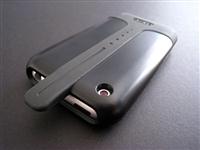Liquidmetal Technology To Power Apple’s Next-Gen Wireless Antenna
 Looks like Apple's ventures in improving the iPhone antenna has not taken a halt. After the recent affair and much fuss created by the antenna of iPhone 4, Apple now plans on using the amorphous metal alloys developed by Liquidmetal Technologies in the design and development of their next generation wireless antenna. Dr. Atakan Peker, the founder of Liquidmetal Technologies has confirmed this in an interview with Cult of Mac. He also mentioned that Apple signed a broad licensing deal with Liquidmetal Technologies. Liquidmetal is also used in the antenna of the Verizon USB727 wireless modem, which is known for its excellent reception.
Looks like Apple's ventures in improving the iPhone antenna has not taken a halt. After the recent affair and much fuss created by the antenna of iPhone 4, Apple now plans on using the amorphous metal alloys developed by Liquidmetal Technologies in the design and development of their next generation wireless antenna. Dr. Atakan Peker, the founder of Liquidmetal Technologies has confirmed this in an interview with Cult of Mac. He also mentioned that Apple signed a broad licensing deal with Liquidmetal Technologies. Liquidmetal is also used in the antenna of the Verizon USB727 wireless modem, which is known for its excellent reception.
 This is not the first time Apple will be using amorphous metal alloys. Apple already uses this technology in its newly released Magic Trackpad. Dr. Peker states that the properties of Liquidmetal make is an excellent substrate for usage as an antenna and could be one of many reasons why it has caught the fancy of Apple.
This is not the first time Apple will be using amorphous metal alloys. Apple already uses this technology in its newly released Magic Trackpad. Dr. Peker states that the properties of Liquidmetal make is an excellent substrate for usage as an antenna and could be one of many reasons why it has caught the fancy of Apple.
Not only this, there are plans for using Liquidmetal in complex and seamless casings for the iPhone, iPod or the iPad. And if this happens, the whole outer casing of the next-gen iPhones could be one big metal alloy antenna. The properties of these amorphous metal alloys also allow it to bend without fatigue or crimping so you could theoretically build one-piece hinges or even foldable devices.
Below you can go through a few properties of this so called Liquidmetal:
- Liquidmetal is generally described as a metallic glass
- It possesses high strength to weight ratio, high wear resistance, and a low softening temperature that allows it to be molded into complex shapes and designs.
- Finds use in various consumer products including sports equipment like the casings of USB thumb drives, MP3 players, and mobile phones.
Again, as expected from Apple, we are definitely going to witness a big innovation in it's flagship mobile device - the iPhone. What do you feel about this new antenna technology, do let us know in the comments.
Images via ArtoftheiPhone, intoMobile